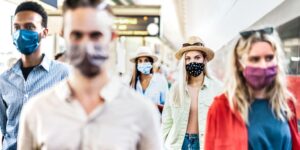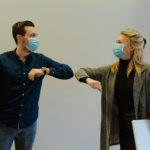 Published 17th December 2020
Published 17th December 2020
As we come to the end of a very different year, it is common practice to look back on events. Obviously the Sars-Cov-2 virus has featured heavily so let’s do a quick review:
Based on collated data from research and observational studies since Feb 2020 it is well understood that the SARS-CoV-2 virus spreads most efficiently among unmasked adult speakers who spend time together in close, unventilated indoor spaces. More so, if when in that space, they insist on talking to each other!
It is also clear that the virus can spread through nonverbal activities. Sneezing and coughing produce virus-encased globs of spittle, and even heavy breathing, especially during a run or vigorous activity, can spray aerosolised droplets that can linger in the air before slipping inside a person’s nose or mouth.
The primary mechanism of transmission of SARS-CoV-2 is via infected respiratory droplets. Viral infection occurs by direct or indirect contact with nasal, conjunctival, or oral mucosa, when respiratory particles are inhaled or deposited on these mucous membranes. This clarifies that mucosal immunity, a barrier and site of adaptive immune triggering, needs to be in tip top condition to prevent infectious events occurring.
The virus however, despite initial concerns does not seem to spread reliably via surfaces. Put simply, COVID-19 is mostly a ‘talking disease’ one that could be better contained with appropriate universal mask wearing, a national campaign that emphasises quiet in public spaces, and clear determinations about indoor gatherings.
This proposal has been explored in Japan, for whilst much of the world emphasised the importance of testing and tracing (with the caveat that testing has limitations on accuracy and tracing has been especially poor in the UK), Japan initially had no mass testing and no sophisticated means of contract tracing. Yet, adjusted for population, the country currently has approximately 98 percent fewer COVID-19 deaths than the United Kingdom.
Much credit has gone to its crystal-clear public guidance to avoid the three C’s: Closed spaces, Crowded places, and Close-contact settings, including “Close-range conversations.” That’s not to say they have not had economic problems, but that there appears to be a strong relationship between social behaviour and risk of adverse outcomes, also seen in many other Asian countries approaches to management.
LOCKDOWN FATIGUE
Naturally, viewed through the lens of an individual experience, the impact of societal compression will vary enormously and as such will create localised and in some cases entrenched opinions that may lead to family, friends and community divisions, with further adverse stress and health challenges.
A recent (Dec 2020) paper from the Institute for New Economic Thinking, To Save the Economy, Save the People First, suggests that lockdowns, whilst difficult, may be the best of the options. A chart in the article (please visit the site) clearly shows how a wide range of countries have followed two primary strategies: suppression, or trading off deaths against the economy.
By and large, the former group (including Iceland) has done better in both respects. Meanwhile, countries that have by virtue of their approach sacrificed lives, have tended to end up with high mortality and economic costs. The single biggest and most consistent difference between the successful Asian countries and those Western countries that continue to struggle with COVID-19, is universal adoption of high-quality mask wearing (applying good practice) and strict adherence to social distancing measures. Implying that whilst painful, the subsequent economic recovery is faster and more even.
The uncomfortable reality is that the related infection, mortality and morbidity does not respond to political or conspiracy ideology, especially when it flies in the face of nature and reality. Those countries who resisted lockdowns and containment measures early in the wave of infections are not, in fact, avoiding lockdowns (i.e Sweden who is now tightening their lockdown rules). The data suggests so far that what they are really doing is guaranteeing that the inescapable lockdown will happen regardless, and will have to be more stringent, and for much longer, because they refused more moderate and focussed action earlier.
PERSONAL SAFETY
Inevitably the challenge for all of us has been the need for rapid comprehension of risk, and defence. The outcome has been varied, slow and in many cases highly traumatic. Ideology, Incoherence, Incompetence, Ignorance and Immunity (the 5 ‘I’s) have all played a part in the consequences to date.
What has become clearer to many, even those who traditionally see nutrition and health as an inconvenient noise, rather than the genuine anchor to personal and public health it is, have begun to change their perspectives. Vitamin D has found a number of international champions and more recently Vitamin C has found increased traction, as well as other nutrients as this Nutritional Therapy in Covid-19 management paper explores.
Genetic variations in risk and outcome, also made the news in Dec following a paper in Nature published on the 30th November 2020. However even the authors recognise that whilst interesting and valuable for further care and drug development, the genetic influence on risk is less than that from lifestyle diseases of diabetes (T2), obesity and the unchangeable ethnicity and age.
THE CONCLUSION
Is that whilst genes load the gun, lifestyle choices, of which nutrition is the most significant, pulls the trigger. Taking on the task of creating a more optimal lifestyle plan, ensuring adequate levels of the required nutrients, sleep, stress management and exercise are safe and secure attributes for individuals and society.
Planning for the next epidemic, as described in this 2018 video featuring the scientist who discovered Ebola, means understanding that ‘spillover’ events are going to occur, and that whilst governments can do their bit – national and local resilience is based on individual reduction of risk and community support. Looking for a Christmas book proposal, consider Dr Gregers’ updated ‘How to Survive a Pandemic.





